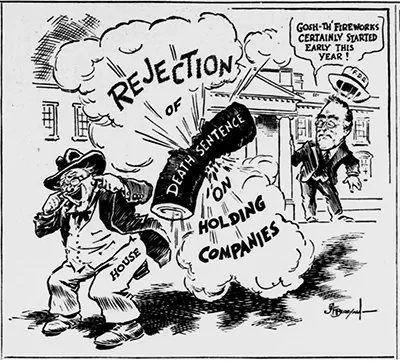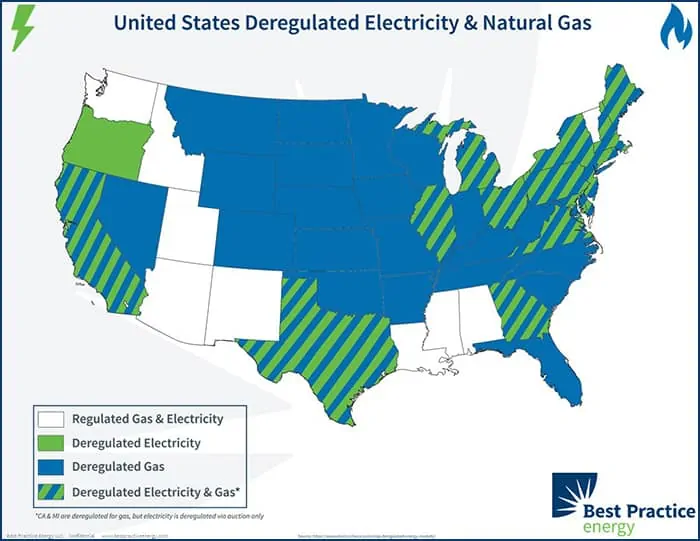Energy deregulation lets both residential and commercial energy users choose which supplier they purchase their electricity or natural gas from.
This is in contrast to residents and business owners simply being on the state-appointed utility energy supply.
Most energy suppliers purchase enough electricity or natural gas from the same generation sources to meet the demand they predict they will need and have the flexibility to offer various types of purchasing strategies buyers can employ. Once a purchasing strategy has been presented to them, they set a rate for their customers based on a multitude of factors.
Think of this like choosing which cellphone provider: while everyone uses a phone from Apple, Samsung, etc., you also choose which provider you want service from (i.e. Verizon, AT&T, etc.). Just like with phone service providers, purchasing from suppliers offers multiple benefits like competitive rates and choosing a purchasing plan that makes the most sense for you, all of which are bolstered by using an energy consultant who knows the ropes.
All that being said, energy deregulation is a fairly “new” concept and is not something that even every state practices.
The History of Energy Deregulation
In the early days of the United States, energy utilities were not regulated; they competed for customers, which actually kept energy prices fairly low. As the population and demand grew, however, so did poor management of the utilities, which led to widely fluctuating prices, poor infrastructure, and spotty service for many users.
The road to energy deregulation is paved in numerous actions by utilities as well as the federal government’s response to constantly arising issues and their attempt to keep prices affordable for the average citizen. Take a look at the timeline below to gain a better understanding of the trail the United States took to energy deregulation.
1935 - Public Utility Holding Company Act (PUCHA)
Passed in response to malicious practices from large utility companies and was meant to help prevent energy monopolies from forming by giving the Securities and Exchange Commission the authority to regulate, license and break up utility holding companies.
1965 - Great Northeast Blackout
Faulty infrastructure on transmission line tripped, which led 30 million people in the US and Canada to be without electricity for up to 13 days.
1968 - North American Electric Reliability Council (NERC)
In response to the Blackout, the NERC was formed and split the US into 10 different energy regions with each region in charge of controlling energy and delivering it reliably. However, monopolies emerged which led to no competition and overcharged users.
1970s - Energy Crisis
The energy crisis of the 70s spiked oil and energy prices. In response, utility companies upgraded plants to generate electricity using coal or uranium, bankrupting many of them. The cost of these projects was passed onto users, which raised their costs significantly.
1977 - Federal Energy Regulatory Commission (FERC)
The FERC was created to take the first step towards energy deregulation as it allowed states to decide how they wanted to supply energy to users. With now standard energy infrastructure, market competition returned to the industry, which helped to lower costs.
1978 - Public Utility Regulatory Polices Act (PURPA)
PURPA was put in place to promote energy conservation, increase use of domestically generated electricity & natural gas, and make energy more affordable by creating a market for power from non-utility producers, ending promotional rate structures, encouraging renewable energy supply, and much more.
1997 - The Energy Policy Act
Set goals, mandates, and changed utility laws to increase the use of clean energy, improve overall energy efficiency, help small utility companies stay competitive with larger ones, broaden the range of resources utilities could choose, and outlined new rate creation standards.
2005 - Energy Policy Act of 2005
Increased responsibilities of the FERC to oversee reliability of the transmission grid, prevent market manipulation, curb greenhouse gas emissions, and review company mergers involving electric utility facilities as well as acquisitions of generation facilities.
So in deregulated states, where does the Utility come into play?
The main purpose of Utilities in deregulated states is to oversee and operate the infrastructure that controls the transmission of electricity and natural gas like powerlines and pipelines. Also, if there is an outage emergency or an issue with power lines, the local utility would be responsible to deal with it.
Additionally, because deregulation is all about the right to CHOOSE where your energy comes from, users can always decide they don’t want to purchase through a supplier and select to receive their energy directly from their local utility.
As you can see on the timeline, the road to energy deregulation has been a long one with many pitfalls and changes along the way, and it’s far from over. It has, however, made great strides in adding a focus on renewable resources and sustainability as well as helping drive down energy costs for users.
In fact, not even every state in the US is deregulated and in many of the ones that are, there are still cities or regions who have yet to adopt this type of model. There are currently 21 states who have deregulated just natural gas, 1 state that just offers deregulated electricity, and 17 states that have deregulated electricity and natural gas (see map below).
There are many reasons on both sides of the coin for this, but having the ability to choose your energy supplier does provide users with more control and leads to increased cost avoidance for businesses and consumers through competitive pricing, contract options, and strategies tailored to a business.
Where do energy consultants and brokers fit into deregulation?
As you probably know by now, navigating your contract in the world of energy deregulation is no small feat. Energy consultants and brokers exist to help energy users understand the power they have and guide them in using that power to take full advantage of deregulation. Best Practice Energy accomplishes this through our turnkey energy management solution, Whole Energy Health, which helps users:
- Develop a cost avoidance strategy for each component of their energy supply price,
- Accurately time the market to purchase away from volatility and buy at all-time lows,
- Design a contract and purchasing strategy that is protective and tailored to the needs and goals of a business,
- Pit suppliers against each other to provide a transparent and competitive view of the market,
- Look for ways to make facilities more efficient and sustainable,
- And manage down usage at precise times, which leads to cheaper future costs.
Energy deregulation is more than just choosing where you are purchasing energy from; it gives you the ability to choose a purchasing plan that is the best fit for you, which is the key to cost avoidance on electricity and natural gas bills. To find out how Best Practice Energy can help you achieve maximum cost avoidance on your bills, contact us today for a free electricity and natural gas consultation!


